ISSN ONLINE(2319-8753)PRINT(2347-6710)
ISSN ONLINE(2319-8753)PRINT(2347-6710)
Chidanand Patil1, Shreekant Narayanakar2, Arjun Virupakshi1
|
| Related article at Pubmed, Scholar Google |
Visit for more related articles at International Journal of Innovative Research in Science, Engineering and Technology
Physical, chemical and bacteriological analyses of water samples from seven bore wells located around landfill site at Turmuri, Belgaum was carried out to ascertain the magnitude of dumpsite pollution on groundwater quality. During the study period, 7 bore wells were selected around the landfill area at a distance of 500, 750 and 1000m. The parameters analyzed during the study period were pH, total dissolved solids (TDS), Total Hardness, Nitrate, Most Probable Number (MPN) and heavy metal such as Lead using standard laboratory procedures. The pH ranged from 6.01 to 7.3 indicating acidic in nature in the month of Feb - March, the three bore wells near landfill i.e. within 500 m. Concentrations of Hardness, TDS, Nitrate and MPN ranged from 0 to 80 mg/L, 49 to 190 mg/L, 4 to 79.89 mg/L and >1600/100ml respectively. The analysis was done for four months from Feb – May. The results showed that within 500 m bore wells were contaminated by E-Coli bacteria, also nitrate concentration is above the permissible level described by WHO and Bureau of Indian Standards for drinking water and pH were acidic in nature. The polluted water requires certain levels of treatment before use. Public enlightenment on waste sorting, adoption of clean technology, using climate change mitigation strategies and the use of sanitary landfill to prevent further contamination of ground water flow are recommended.
Keywords |
| Groundwater, Landfill, Total Dissolved Solids (TDS), Hardness, Most Probable Number (MPN). |
INTRODUCTION |
| Groundwater is a globally important and valuable renewable resource for human life and economic development. It constitutes a major portion of earth’s water circulatory system known as hydrological cycle and occurs in permeable geologic formation known as aquifers i.e. formations having structure that can store and transmit water at rates fast enough to supply reasonable amounts to wells. Waste includes all the discarded solid materials from commercial, municipal, industrial and agricultural activities [1]. Groundwater pollution is mainly due to the process of industrialization and urbanization that has progressively developed over time without any regard for environmental consequences. In recent times, the impact of leachate on groundwater and other water resources has attracted a lot of attention because of its overwhelming environmental significance. Leachate migration from wastes sites or landfills and the release of pollutants from sediments (under certain conditions) pose a high risk to groundwater resource if not adequately managed. Open dumps are the oldest and most common way of disposing off solid wastes, although in recent years, thousands have been closed, many are still being used. Waste management has become increasingly complex due to the increase in human population, industrial and technological revolutions and the processes that control the fate of wastes in the soil is complex and many of them are poorly understood. Issues such as nutrients release rate and other chemicals, leaching of nutrients, metals through macro pores as suspended solids and sludge organic matter on the sorption degradation are often not understood by many. Leaching of hydrophobic organics and long term bioavailability and fate of metals fixed by soil organic matter needed to be studied to have a better approach in handling groundwater pollution. Toxic chemicals that have high concentration of nitrate and derived from waste in the soil can filter through a dump and contaminate both ground and surface water. Insects, rodents, snakes and scavenger birds, dust, noise, bad odour are some of the aesthetic problems associated with sanitary landfill [2]. The volume of solid waste generated in Belgaum City, Karnataka has increased significantly over time from an estimated quantity 58400 tons per year (160 tons/day) in 2009-10 to 65700 tons per year (180 tons/day) in 2012 [3]. Because of increase in population, industrial and economic development. The total assessment revealed that about 75% total waste is organic in nature, 23% of plastic, nylon and 2% metal. Increasing waste generation and disposal resulted in increase groundwater pollution. To what extent this pollution has affected the water wells in the area is unknown and hence needed to be determined. The objective of the study therefore was to assess the effect of landfill pollution on groundwater quality in Belgaum, Karnataka. |
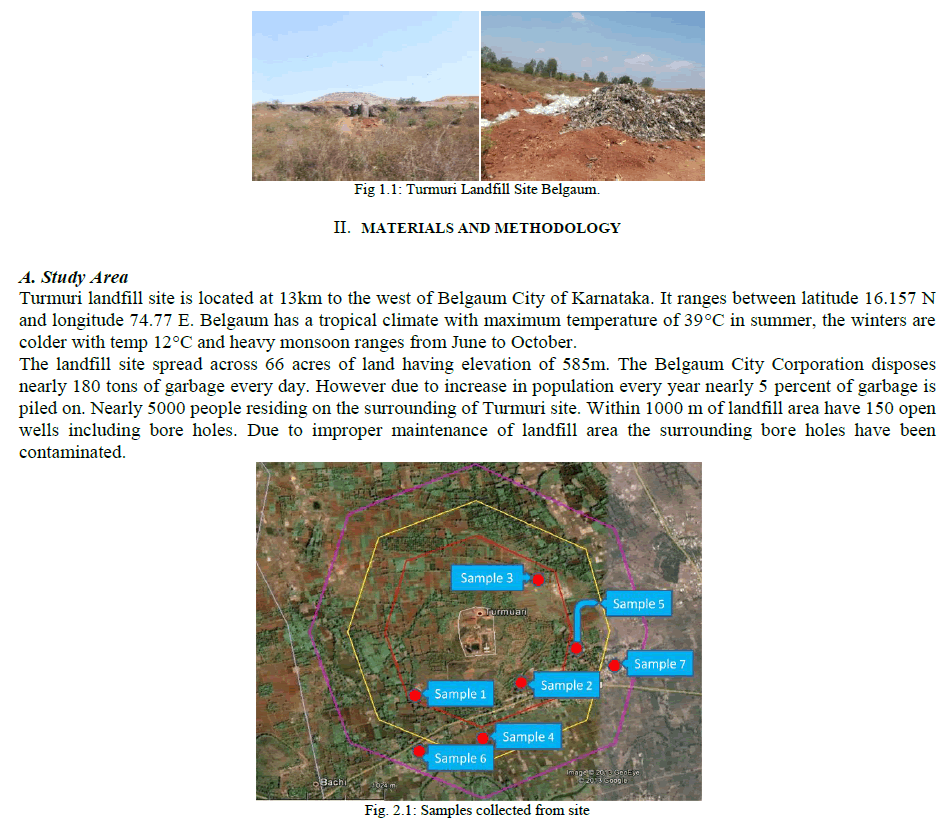 |
| B. Field sampling and water analysis The study area having many open wells including bore wells within 1000m around the landfill site. Three bore well samples S1, S2, S3 were collected within 500 m, two bore well samples S4, S5 were collected between 500 – 750 m and two bore well samples S6, S7 were collected within range of 750 – 1000m away from landfill site. Samples were collected and analysed for different parameters at different time intervals. The most suitable bottles to use are made from polyethylene or glass. All samples should be properly labelled with details of the source, date of sampling, time of sampling and address. Sample containers for bacteriological examinations must be of glass and sterilized before use by heating for sometime at 1800C together with their stoppers. The samples should be tested in laboratory within 24 hours from the time of collection [10]. The analyses covered physical, chemical and bacteriological parameters of water samples from each bore well. The qualitative analyses were carried out at the Chemical analysis laboratory. The samples were analysed for pH, total dissolved solids (TDS), total hardness, nitrate (NO- 3) were carried out in the water laboratory using standard methods for the examination of water [10]. The concentrations of heavy metal such as Lead in water samples were determined with flame atomic absorption spectrophotometer. Also, bacteriological assay was used in the determination of Escherichia Coli bacteria. All the results were compared with the World Health Organization (WHO) and Bureau of Indian Standards for drinking water. |
III. RESULTS AND DISCUSSIONS |
A. Chemical and Bacteriological characteristic of ground water. |
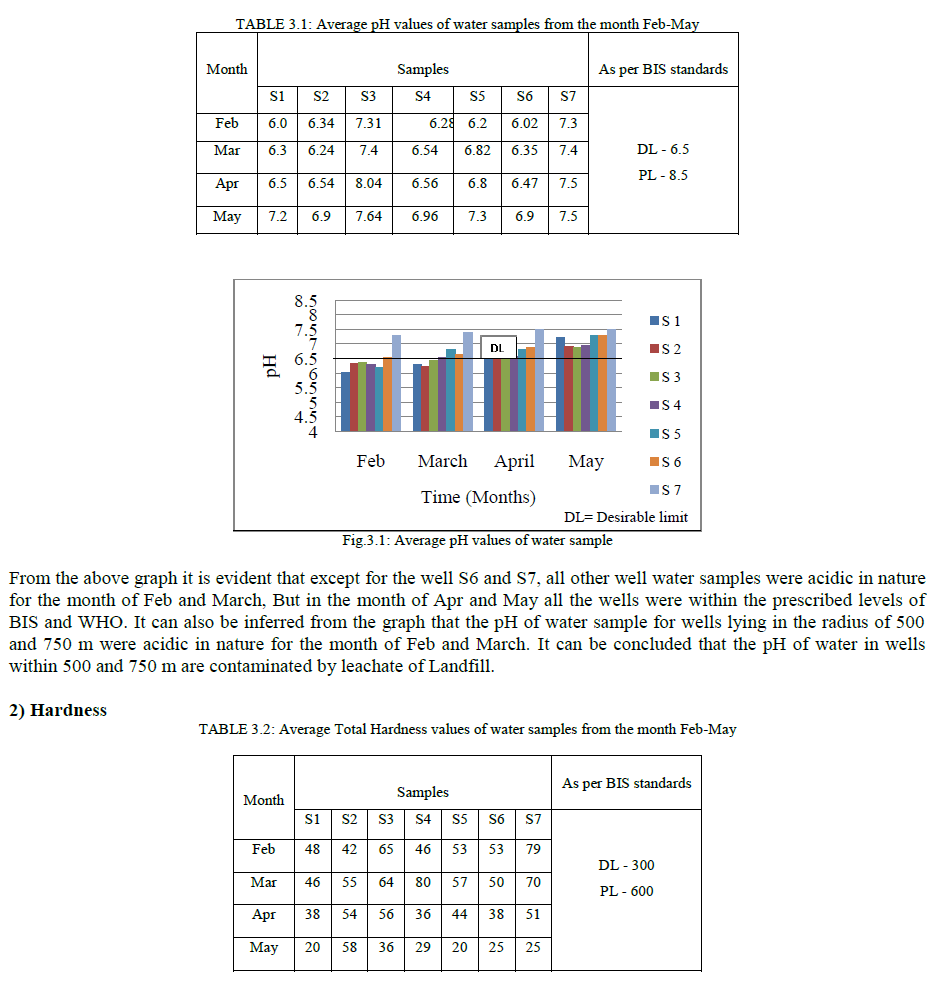 |
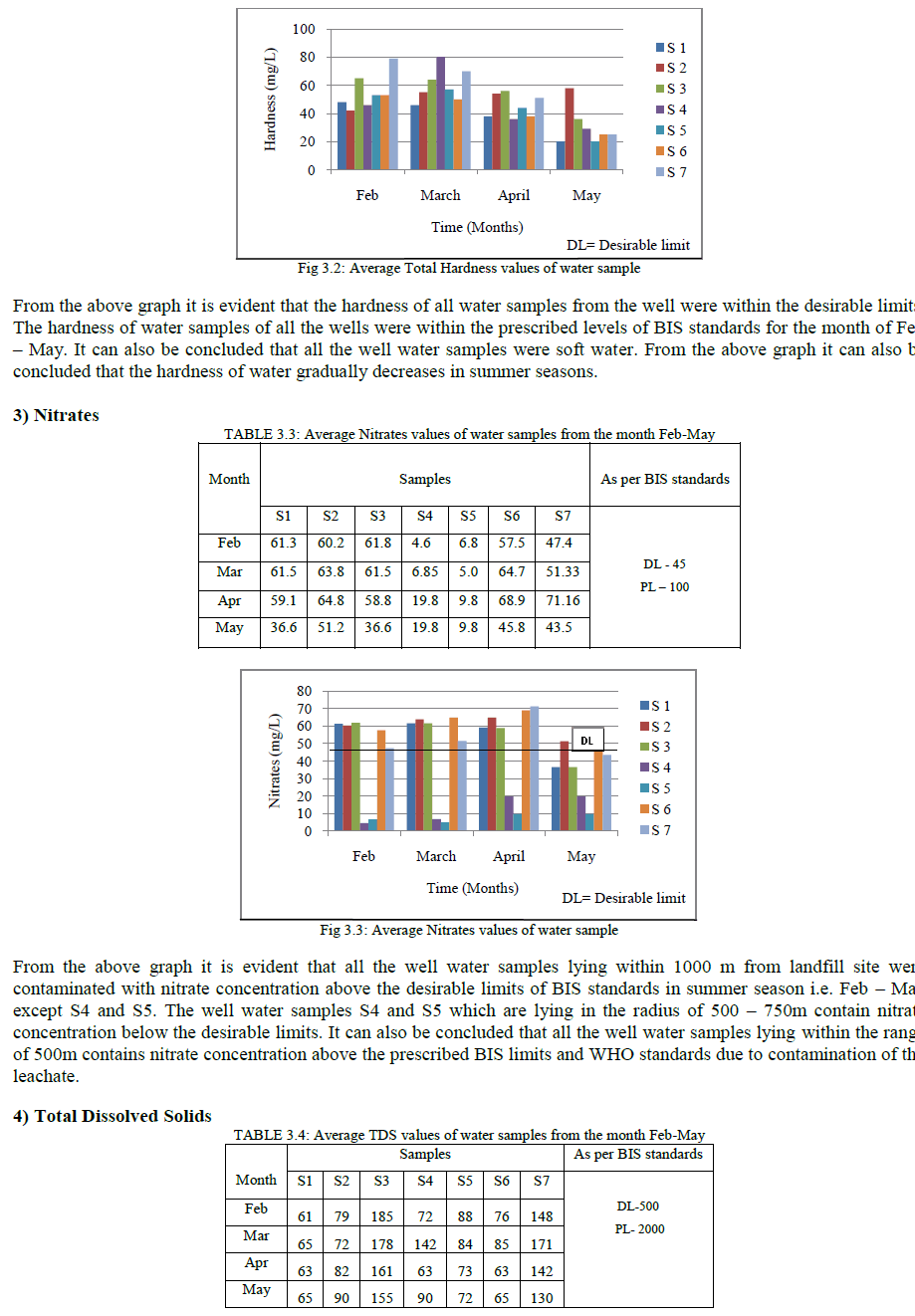 |
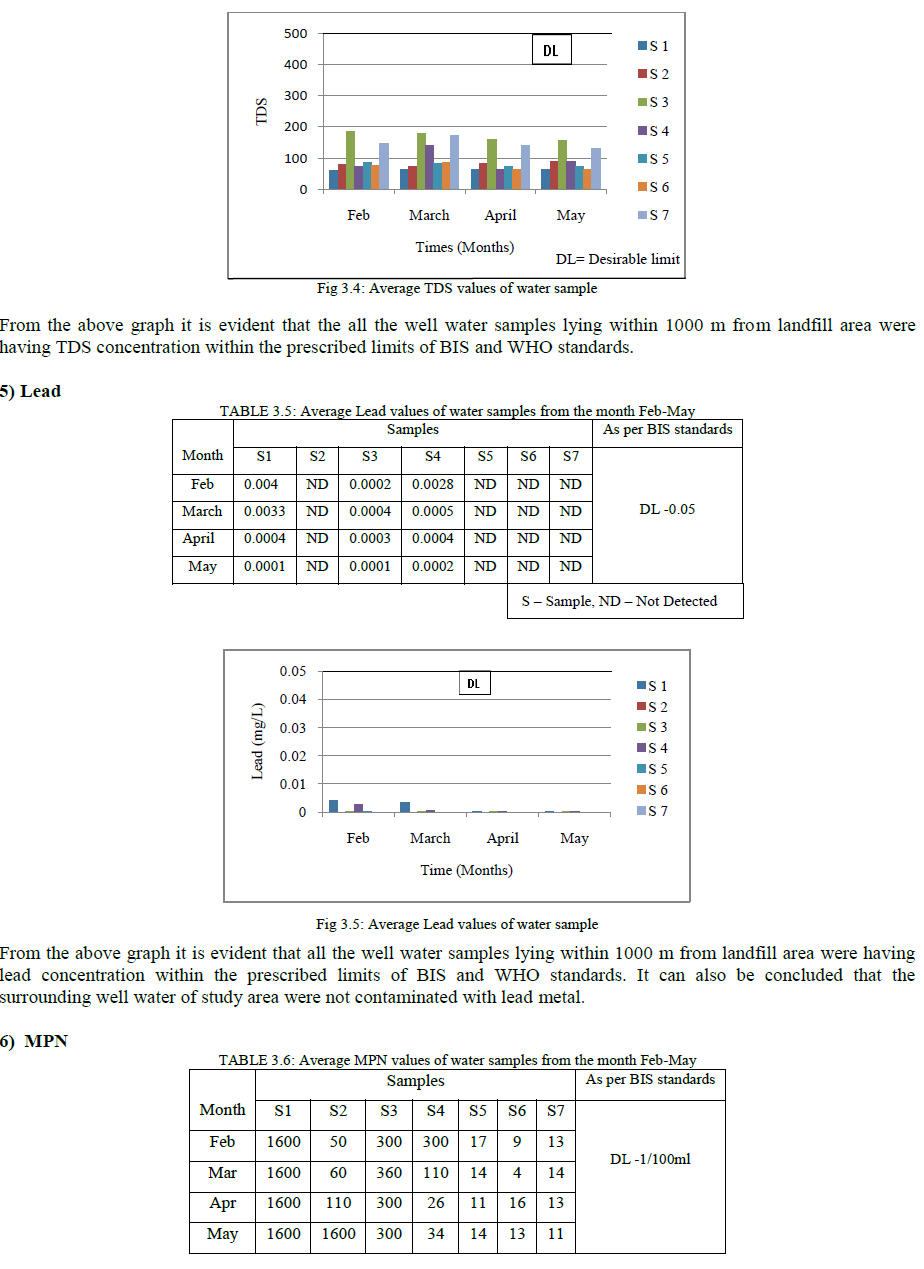 |
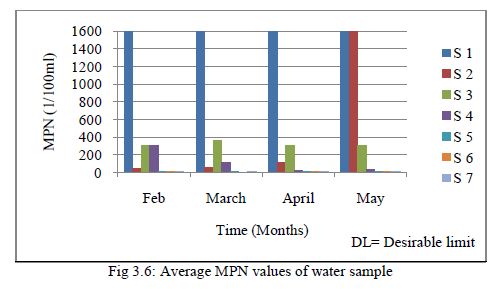 |
| From the above graph it is evident that the well water samples lying within the 500 m from landfill area were contaminated with E-Coli bacteria as it exceeds the prescribed limits of BIS and WHO standards. Among all the wells S1, S2 and S3 are highly contaminated, where as the wells S4, S5, S6 and S7 were within the prescribed limits of BIS and WHO standards. |
IV. CONCLUSIONS |
| From the results of the study, the following conclusions can be drawn 1) Except S6 and S7 all the wells i.e. (S1, S2, S3, S4 and S5) were acidic in nature for the month of Feb – March. Further in the month of April and May all the wells were within the prescribed levels of BIS. 2) During the study period it was observed that, the hardness of water samples of all the wells were within the prescribed levels of BIS. 3) During the study period it was observed that TDS of all the wells were within the prescribed limits of BIS and WHO standards. 4) During the study period it was observed that Lead (Pb) of all the wells were within the prescribed limits of BIS and WHO standards. 5) It was also observed that the wells lying within the 500m, from the landfill area were contaminated with E-Coli bacteria , where as the wells within the 500 – 1000m were within the prescribed limits of BIS and WHO standards. 6) The above result indicates very poor sanitation and damaging effects to health of both man and animals if surrounding well waters were used for domestic purpose. 7) From the study, it can be recommended that re-designing of sanitary landfill with clay or plastic liners to prevent leachate from getting to water table, adoption of clean technology for recycling greenhouse gases emanating from the landfill and a sustainable land management programmed for reclamation insisted. |
References |
|